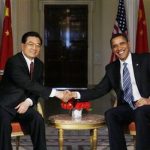I was struck last night when I checked Dawn‘s website for any updates on yesterday’s bombings and saw the following headlines next to each other: ‘Suicide bombs in two Pakistan cities kill 12’ and ‘Pakistan warns against India nuclear support’. It was like seeing it there in black and white the two national priorities, one working against the other to hold back progress.
Pakistan is under attack by jihadi militants. Yesterday’s bombings – one of which carried out by a teenager – were carried out against Pakistani citizens in Karachi and Lahore. Responsibility for the attacks was immediately claimed by Taliban. It is an act of war on the nation.
On the other hand there is India which we continue to battle in a ‘cold war’ of our own. Ambassador and Permanent Representative of Pakistan to Geneva Zamir Akram yesterday warned the international community on bringing India in the Nuclear Suppliers Group (NSG) and other bodies that allow trade in nuclear material. In the meantime, onions sit rotting at the border as a monument to the lack of constructive dialogue between our nations.
Years of misguided policies of ‘strategic depth’ have left us with enemies on both borders – one attacking us with suicide bombers, the other a looming threat of nuclear annihilation. We need a new strategy.
 Ambassador Maleeha Lodhi describes the US-China relationship in The News yesterday as one of careful balance of interests between two nuclear superpowers
Ambassador Maleeha Lodhi describes the US-China relationship in The News yesterday as one of careful balance of interests between two nuclear superpowers
Why can’t we have the same with India?
The usual excuse is that India cannot be trusted and we must be careful never to sell out our country. In India, the same accusation is made about us. As neighboring countries, this is an impasse that we have to overcome. We cannot change geography and move to the other side of the world, and even if we could, would it make a difference? China and the US are on opposite sides of the world and still they are obsessed with each other.
The difference between our relationship with India and American relationship with China is that the US and China have figured out a way to work through their differences, despite those differences being much greater than ours and India’s.
Pakistan and India are both essentially parliamentary democracies with capitalist economies. We both share a common history, and we are geographically, linguistically, and culturally close also. We differ in our majority religions, but there are Hindus in Pakistan and Muslims in India also.
 Compare this to the US and China which exist on opposite ends of the Earth and have no common history. Linguistically the two nation’s area also worlds apart – Americans speaking English, a stress language, while the Chinese language is tonal. Americans are very religious and predominantly Christian while Chinese government is officially atheist, though the dominant religion of the people if Buddhism.
Compare this to the US and China which exist on opposite ends of the Earth and have no common history. Linguistically the two nation’s area also worlds apart – Americans speaking English, a stress language, while the Chinese language is tonal. Americans are very religious and predominantly Christian while Chinese government is officially atheist, though the dominant religion of the people if Buddhism.
Despite these differences, the US and China have found a way to be mutually beneficial partners. That doesn’t mean that either country sells out its interests, either. According to Ambassador Lodhi, both the US and China stand behind their own national interests while using their shared interests as a starting point for identifying ways to cooperate and move forward.
The question raised for the future of Sino-American relations is how economic interdependence will be balanced with issues of contention on which both sides have firm positions. Writing before President Hu’s visit, Henry Kissinger, the architect of the opening of US relations with China, warned against self-fulfilling prophesies on both sides by those who emphasised conflict rather than cooperation.
“Conflict is not inherent in a nation’s rise and Sino-US relations need not take that turn.” Pointing out that on most issues the two countries have been adequately cooperating, Kissinger suggested that what they lacked was an overarching concept for that cooperation. This he said was hard to come by in a globalised world that imposes a multiplicity of new tasks at a moment of political, economic and technological transformation. Kissinger saw reconciling the two countries self-perception of their exceptionalism as the “deepest challenge” of Chinese-American relations.
Pakistan and India governments need to study and approach our relations from this model. With a $1.5 trillion economy, India is a market that Pakistani businesses should have access to. India is also a stable country, unlike our neighbor to the West. While we will continue to make sure our Eastern border is secure, increasing trust base on mutual security would allow us to put more resources to work securing the border with Afghanistan where most of the trouble is. Like the US and China, the greater our economic connections with India, the less we’ll have to worry about Indian aggression.
We have followed a model of mutual suspicion and isolation for sixty years. The results have been near disaster. But it doesn’t have to be this way. Pakistan and India are not the only two nations with both differences and commonalities in their interests. It’s time we stop focusing on the differences and start using our common interests as a place to build a new future.
![]()





